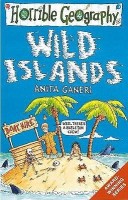 Title: Horrible Geography – Wild Islands
Title: Horrible Geography – Wild Islands
Author(s): Anita Ganeri, Mike Philips (ilustrator)
Release year: 2004
Publisher: Scholastic
Why in Database: There are some turtle mentions in this book – mostly related to the Galapagos and local turtles.
The first mention is in the text in the speech bubble of one of the characters, the guide to the islands:
Depending on which island you choose to live on, you’re more likely to meet tortoises the size of cars and larger-than-life lizards with bad breath.
The next two fragments come from the page where there is also a large, two-page drawing of turtles – we also attach it below, in the section with covers:
1. Giant Tortoise
Habitat: Galapagos Islands.
Appearance: Er, like a giant, and i mean GIANT tortoise. It can grow 1,5m long and weight a quarter of a tonne. Imagine having one of these outsized reptiles rummaging around athe the bottom of your garden!
These whoopers were once so common, visitors claimed they could use them as giant stepping-stones and walk long distances across their backs. Without touching the ground once! But early sailors killed so many for their meat, they almost wiped them out. Get this. the sailors bundled them into the ships’ holds, STILL ALIVE and turned upside down on their backs, for weeks on end. they said it kept the meat nice and fresh, like sort of a tortoise takeaway. Horribry cruel, i know. Especially as these giants can live to the ripe old age of 200 in the wild. What’s that, sir? No, we don’t allow visitors to feed them. They normally eat almost any kind of fruit or veg but the’re not really fussy These beauties would eat you out of house and home, gien half a chance. Including your tent and clothes.
Another mention comes from the stylized as authentic record of Charles Darwin’s memoirs, next to it there is also a drawing of him on a turtle (we attach it of course, in section with covers):
I even got to ride on a giant tortoise, though it was a bit wabbly and I almost fell off.
Another fragment is about Darwin and his discovery/formulation of the Theory of Evolution:
It was the same with the tortoises. Their diffrent-shaped shells allowed them to reach plants high up or low down.
The next mention is in the description of the Galapagos, a curiosity about the name:
The name Galapagos comes from a Spanish word for tortoise. So you could say giant reptiles put these farout islands on the map.
The last mention takes place in a loose summary of what the reader could read/see so far:
So you’ve gawped at truck-sized tortoises, had a big, sloppy kiss from a dragon, and ogled at amazing aye-ayes.


Author: XYuriTT
